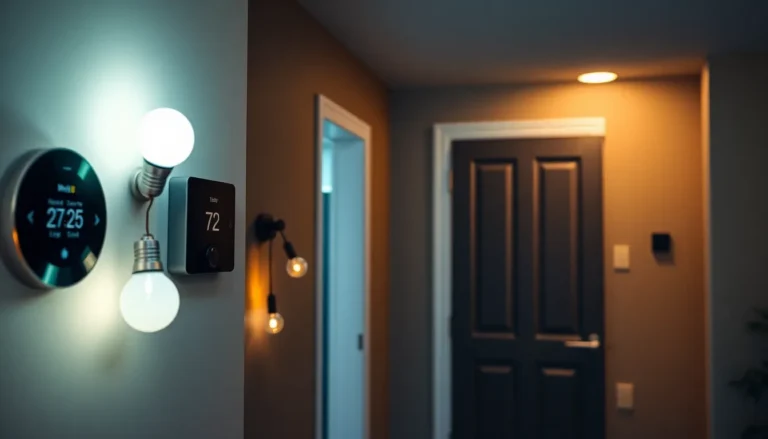In a world where your toaster might just be plotting to join the Wi-Fi network, understanding IoT standards becomes crucial. These standards act like the universal translator for devices, ensuring they can all play nice together in the grand digital playground. Without them, your smart fridge might decide to take a vacation while your smart oven throws a temper tantrum.
Table of Contents
ToggleOverview of IoT Standards
IoT standards play a critical role in ensuring seamless communication among diverse devices. These standards define protocols and frameworks that facilitate interoperability. Without agreed-upon guidelines, devices from different manufacturers could malfunction or behave unpredictably.
Numerous organizations contribute to establishing IoT standards. The Internet Engineering Task Force (IETF) works on Internet protocols, while the Institute of Electrical and Electronics Engineers (IEEE) focuses on networking technologies. The International Organization for Standardization (ISO) also develops relevant international standards.
Specific standards govern various aspects of IoT functionality. For connectivity, protocols like MQTT and CoAP provide efficient data transmission. Security standards, including those from the Internet Security Research Group, help safeguard data integrity and privacy. Additionally, data formats like JSON and XML enable structured data exchange.
Adoption of IoT standards offers significant advantages. Increased compatibility across devices simplifies integration. Enhanced security measures protect sensitive user data. Standardized frameworks can reduce development costs, making IoT solutions more accessible.
Industry collaboration remains essential in advancing IoT standards. Stakeholders, including manufacturers, developers, and policymakers, must engage in open dialogues. Effective collaboration fosters continuous improvement and results in more robust solutions.
Emerging technologies, such as 5G networks, also shape the future of IoT standards. As new devices and use cases arise, existing standards must evolve. Staying up-to-date on industry trends ensures that standards remain relevant and effective.
Importance of IoT Standards

IoT standards play a vital role in the ecosystem of connected devices. These standards create a foundation for seamless interaction between devices, enhancing overall efficiency.
Enhancing Interoperability
Interoperability among devices relies heavily on predefined standards. Protocols like MQTT and CoAP facilitate smooth communication, ensuring that devices from different manufacturers operate harmoniously. Compatibility improves user experience when devices can easily exchange data. Organizations such as the IEEE and ISO work to establish these essential frameworks, fostering cooperation across industries. Without these standards, users might encounter frustrations, as devices may fail to communicate effectively. The collaborative efforts of these organizations support continuous advancements in interoperability.
Ensuring Security
Security is crucial in the realm of IoT. Many users express concerns regarding data breaches and unauthorized access, highlighting the need for robust security measures. Standards provide guidelines for encrypting data and securing communication channels. Protocols ensure that only authorized devices can access sensitive information, mitigating potential threats. Awareness of vulnerabilities leads to the development of enhanced security features. By adhering to established security standards, manufacturers create safer environments for users, fostering trust in IoT technology.
Key IoT Standards Organizations
Numerous organizations play critical roles in establishing IoT standards, ensuring devices communicate seamlessly across various platforms.
International Organization for Standardization (ISO)
ISO develops and publishes international standards, which enhance interoperability in IoT applications. This organization focuses on defining protocols that guide device communication and data exchange. ISO standards cover aspects such as quality management, security, and environmental assessment. An example includes ISO/IEC 27001, which outlines requirements for information security management systems. Adoption of ISO standards encourages global consistency, fostering collaboration among manufacturers, developers, and users.
Internet Engineering Task Force (IETF)
IETF focuses on the development of internet standards, with significant contributions to IoT protocols. This organization plays a vital role in ensuring the scalability and reliability of IoT networks. For instance, IETF’s Message Queuing Telemetry Transport (MQTT) protocol is widely used for lightweight messaging in constrained environments. Another critical protocol is Constrained Application Protocol (CoAP), which facilitates communication in low-power networks. By defining these protocols, IETF enhances the overall efficiency and effectiveness of IoT deployments.
Institute of Electrical and Electronics Engineers (IEEE)
IEEE sets standards that govern various aspects of electronics and communication, particularly within IoT ecosystems. This organization is well-known for its contributions to networking and data transfer protocols. The IEEE 802.15.4 standard supports low-rate wireless personal area networks, crucial for many IoT applications. Additionally, IEEE promotes security standards to ensure data integrity and user privacy. These efforts reflect IEEE’s commitment to advancing technology that sustains a reliable and secure IoT environment.
Popular IoT Standards
Numerous standards play a crucial role in the Internet of Things ecosystem, fostering interoperability among devices. These standards ensure that devices communicate seamlessly while maintaining security and reliability.
MQTT
MQTT, or Message Queuing Telemetry Transport, focuses on lightweight messaging. This protocol, designed for low-bandwidth scenarios, enables efficient communication among devices. It operates on a publish-subscribe model, where devices send messages to a topic instead of each other directly. MQTT’s simplicity and flexibility make it suitable for various IoT applications, such as remote monitoring and home automation.
CoAP
CoAP, short for Constrained Application Protocol, serves the needs of IoT systems operating on limited resources. It emphasizes low overhead and simplicity, adapting well to constrained devices and networks. CoAP also supports RESTful interactions, allowing devices to communicate easily over HTTP-like requests. This capability proves advantageous for applications like smart lighting and environmental monitoring.
Zigbee
Zigbee is a wireless networking standard designed for short-range communication in mesh networks. This protocol excels in low-power applications, making it ideal for battery-operated devices. Zigbee supports a variety of device types, facilitating automation in smart homes and building systems. Its ability to connect multiple devices without direct line-of-sight enhances its usability in real-world environments.
LoRaWAN
LoRaWAN, or Long Range Wide Area Network, specializes in long-range, low-power wireless communication. This standard enables devices to transmit data over significant distances while conserving battery life. By utilizing unlicensed frequency bands, LoRaWAN supports diverse applications, including smart agriculture and urban infrastructure. Its scalability makes it suitable for large IoT deployments, connecting thousands of devices effortlessly.
Future of IoT Standards
Anticipation surrounds the future of IoT standards as technology evolves rapidly. Emerging trends drive the need for robust and adaptable standards tailored for complex environments. Increased demand for scalability becomes evident with the expansion of IoT devices, emphasizing the role of organizations like IEEE and ISO in producing flexible guidelines.
Interoperability remains a focal point as diverse devices proliferate in various sectors. Industry stakeholders prioritize collaboration to create unified standards that enhance functionality across different platforms. The rise of edge computing accelerates this need, providing opportunities for standards to address decentralized processing and data management effectively.
Security concerns continue to gain attention. Enhanced standards for encryption and data protection will become essential as cyber threats grow more sophisticated. Organizations are expected to adopt comprehensive frameworks that instill confidence in users, ensuring their data remains secure across all IoT devices.
Emerging technologies, such as 5G, are set to reshape how standards evolve. Faster connectivity facilitates real-time data exchange, motivating standardization efforts that accommodate higher bandwidth and lower latency. As a result, IoT ecosystems will significantly benefit from standards designed to leverage these advancements.
International collaboration will catalyze the development of innovative standards. Global consensus will not only streamline international trade but also enhance compatibility among devices. Future IoT environments will likely thrive on these synergies, making enhanced interoperability a shared goal for organizations worldwide.
The future of IoT standards is bright and full of potential. As technology continues to advance the need for robust and adaptable standards becomes increasingly critical. Interoperability will remain a key focus as industry stakeholders collaborate to create unified standards that enhance device functionality across various platforms.
With the rise of emerging technologies like 5G and the growing complexity of IoT devices enhanced security measures will also be essential. International cooperation will play a vital role in developing innovative standards that not only streamline global trade but also improve compatibility among devices.
Ultimately the evolution of IoT standards promises to foster a more interconnected and efficient IoT ecosystem benefiting users and industries alike.










